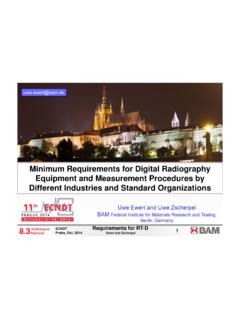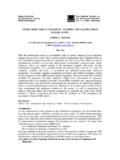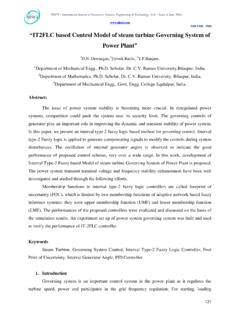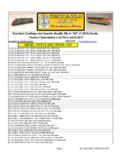Transcription of Inspection of Defects in Rails using Ultrasonic Probe
1 Inspection of Defects in Rails using Ultrasonic Probe Samuel Tony Vipparthy Department of Mechanical, Assistant professor in Swarnanadhra institute of engineering & technology Narsapuram, West Godavari, Andhra Pradesh, India 534280 Abstract The detection of critical inherent cracks in the railhead is a major challenge for the railway industry. Conventional Inspection methods have proven not to be reliable enough in this context; therefore the aim of this work is to develop an alternative screening method. The approach is to scan a pulse-echo Probe along the rail which covers maximum part of rail head. The properties of the dominant surface of Rails were determined and a mode suitable for Inspection purposes is identified. In order to ensure correct and reliable signal interpretation of Ultrasonic wave a signal processing method is developed.
2 The performance of this method was studied on Rails containing artificial and real Defects . Furthermore, deep Defects were detected even with multiple smaller ones in front. The Inspection method developed appears suitable for defect detection and could be used to complement existing methods and thus enhance their reliability. Keywords: Rail tracks, Ultrasonic testing, pulse-echo Probe , Defects . TESTING (UT) Ultrasonic testing (UT) is a non-destructive Inspection method that uses high frequency sound waves (ultrasound) that are above the range of human hearing, to measure geometric and physical properties in materials. Ultrasound travels in different materials at different speeds (velocity). However, the speed of sound propagation in a given material is a constant. There are several ways that sound travels through a material.
3 One type of sound wave, called longitudinal or compression travels about 330 metres per second in air and about 6400 metres per second in aluminium or in steel at approximately 5960 metres per second. To perform UT, electrical energy is converted to mechanical energy, in the form of sound waves, by a transducer. The transducer accomplishes this energy conversion due to a phenomenon referred to as the piezoelectric effect. This occurs in several materials, both naturally-occurring and man-made. Quartz is a naturally occurring piezoelectric material. A piezoelectric material will produce a mechanical change in dimension when excited with an electronic pulse. Similarly, this same material will also produce an electric pulse when acted upon mechanically. An example of the common use of piezoelectric materials is found in the electronic lighters available for starting gas stoves, gas grills, cigarette lighters, etc.
4 In these examples, the piezoelectric crystal is squeezed and released suddenly to result in the generation of an electric spark that jumps across a gap to ignite the gas. TESTING BY Ultrasonic Sound in the frequency range of 500 x 103 cycles/sec(500 KHz.) to about 50 x 106 cycles/sec. (50 MHz.) is used for "Material Testing by Ultrasonics". It is above the human audible range and hence it is called Ultrasonic . Ultrasonic is the most extensively used NDT method. It has following inherent advantages over other methods. Safe Gives instant results Can penetrate high thickness Economical Can generate instant "Test Report" Can detect majority of types of Defects Easy to introduce automation Following are the types and sub-types of Ultrasonic Testing. Material testing for surface/internal discontinues 1. Detecting discontinuity 2. Locating discontinuity 3.
5 Evaluating discontinuity 4. Diagnosing discontinuity Wall thickness Measurement 1. Remaining (Residual) thickness measurement. 2. Checking dimensions of a solid object. Material Characterization. 1. Determining Physical Properties. 2. Percentage modularity in SG Cast Iron. A list of methods used to detect flaws in Rails : 1. Ultrasound - the most popular method 2. Eddy current Inspection - great for surface flaws & near surface flaws 3. Magnetic Particle Inspection (MPI) - used for detailed manual Inspection 4. Radiography - used on specific locations (often predetermined) such as bolt holes and where thermite welding was used 5. Magnetic induction or Magnetic flux leakage - earliest method used to locate unseen flaws in the railway industry. TYPES OF WAVES 1. Longitudinal Waves 2. Shear Waves 3. Surface or Rayleigh Waves TYPES OF Rails Flanged rail Baulk rail Barlow rail Vignoles rail Flanged T rail Double-headed rail Bullhead rail Tangential turnouts Grooved rail LR55 rail TYPES OF GAUGES Standard Gauge Broad Gauge Narrow Gauge 2.
6 WORKING PRINCIPLE: A number of techniques have been used in Ultrasonic testing for the design of different equipment s. Some of these techniques are: (1) Frequency modulation. (2) Pulse echo. (3) Transmission. (4) Resonance. (5) Acoustic range. on the Indian railway frequency modulation and pulse echo technique only are used and these are discussed in details in subsequent paragraphs. Pulse Echo System In the pulse echo technique, a pulse Ultrasonic beam of a very high frequency is produced by the pulse generator and sent in the rail. At the opposite face, the Ultrasonic waves are reflected and the echo is picked up by the crystal transducer. A discontinuously or defect in the rail will also send back the echo. The time interval that occurs between the initial pulse and the arrivals of echo received, the flaw can be detected by the relative position and amplitude of the echo.
7 There may be a number of multiple reflections of the echo but one arising due to fault can easily detect. Ultrasonic RAIL TESTING EQUIPMENT On Indian railway Ultrasonic rail flaw detection is carried out with the help of two different types of equipment viz. single rail tester and double rail tester. The single rail tester has been utilised on the Indian railways for over 35 years and the double rail tester is of a relatively recent origin. Single Rail Tester Single rail tester is capable of testing only one of the Rails at at time is provided with five probes 00 and 700 backward (b) 370 forward (f) and 370 backward (b) . The normal Probe (00) is utilised for the purpose of detecting horizontal Defects situated in head, web or foot. The 700 Probe has been specially provided for detecting Defects in the rail head, the most typical of which is the transverse fissure of kidney fracture 370 probes have been provided to find out defect originating from the bolt hole such as star cracks etc.
8 The signal received from the Defects by any of the above Probe is indicated on the cathode ray tube screen. In order to find out the origin of detection which Probe has picked up the defect, provision for eliminating the individual Probe operation has been made in the equipment Single Rail Tester Double Rail Tester The double rail tester is capable testing both the Rails at a time. However for each rail, only three probes have been provided for present 70o and 700 backward. This equipment, unlike the single rail tester, has multichannel facility the signal received from each Probe can be instantaneously distinguished without taking recourses to process of elimination. There are three modes in the equipment of defect indication CRT audio alarm and LED display The normal Probe is provided for detection of horizontal Defects and 00 and 700 probes have been provided for transverse Defects in the head.
9 For detection of bolt Defects the equipment works on the principle of backward drop, which in the event of a bolt whole crack shows reduction in echo- amplitude of the back wall it is also supported by separate audio alarm distinctly different tone and LED. The introduction of double rail tester has been specifically made for enhancing the productivity of testing and as well as improving the quality and accuracy of flaw detection. Due to pre calibrated arrangement, frequency setting of the equipment is not considered necessary. 50 Due to frequent misalignment of probes on the fishplate joints and limitations of detection of bolt hole crack having unfavourable orientation and size, it is desirable to display to deploy double rail tester on LWR/CWR Multi Probe Rail Testing Trolley This is the most common type of equipment used on Indian railway for detecting flaws in the Rails .
10 There are two probes normal Probe and angle Probe , both of which act independently. the Probe material used for detection of Ultrasonic waves is barium titanate producing and transmitting vertical Ultrasonic waves of 4 mega cycles frequency through vertical Probe and 2 mega cycle frequency through angle Probe . The height of the Probe above the rail surface can be adjusted in the holder assembly. The normal Probe is powerful enough to scan the entire rail depth for Defects . it can detect longitudinal discontinuities in the head at junction of either web or the foot or web well as cracks from the bolt holes .it cannot, however, detect vertical cracks. the Defects from the normal Probe are represented on the oscilloscope screen in the form of firm echoes protruding from a baseline. Ordinary, two echoes are visible on the screen, the initial echoes due to part reflection of the waves from rail top and back echo from the bottom of the rail.
















